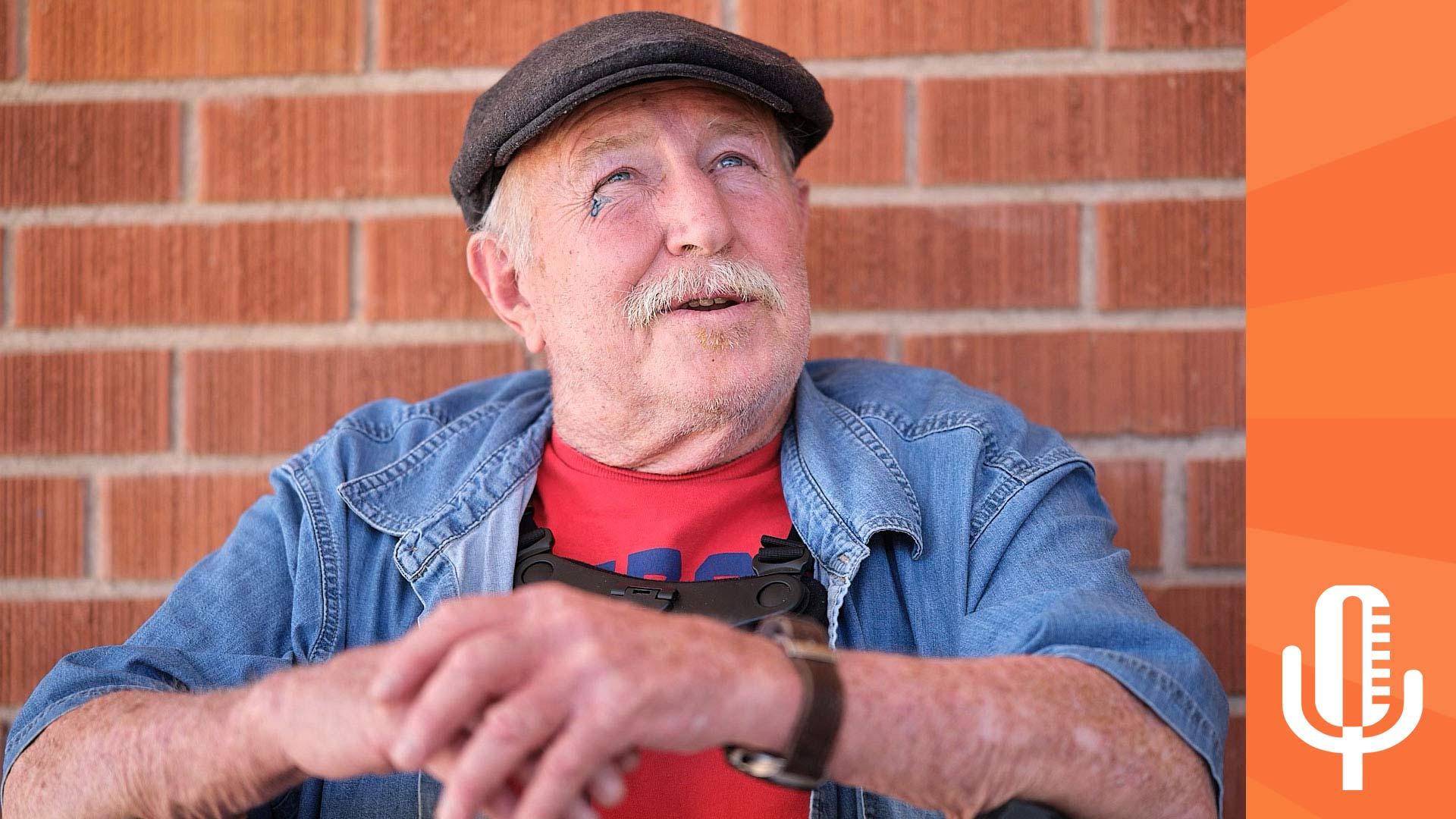 Pat Grenier, a Tucson native and former carpenter, has spent years cycling between the Pima County Jail and court-mandated mental health treatment. His family says many of the institutions designed to help the mentally ill and their families still have major gaps in service.
Pat Grenier, a Tucson native and former carpenter, has spent years cycling between the Pima County Jail and court-mandated mental health treatment. His family says many of the institutions designed to help the mentally ill and their families still have major gaps in service.
The Buzz February 21, 2025

Join us on March 18, 2025, for a panel discussion about the Pima County Jail. Click here for more information.
Welcome to the Buzz, I’m Christopher Conover. This week, we examine mental healthcare in the justice system.
When a year-long investigation of the Pima County Jail gave the public concrete evidence of crumbling buildings and inadequate healthcare, many were frustrated. But the county decided a new jail was too expensive.
The whole process left those closest to the system with many more questions than answers.
In particular, how is the county’s failing justice infrastructure going to adapt to a community with increasing levels of mental illness and chronic health conditions?
AZPM has partnered with Arizona Luminaria to tell the story of one man as he navigates the justice system while struggling with mental illness for over 20 years.
Pat’s family has spent thousands of dollars and immeasurable amounts of emotional energy into supporting him…but in a system that lacks empathy and prioritizes punishment, not prevention.
AZPM’s Hannah Cree and AZLuminaria’s John Washington take it from here.
Hannah Cree: When mental health makes day-to-day function difficult, facing eviction from your home can turn a tough situation into a nightmare.
Pat Grenier: “I am dismayed. I’ve been made homeless by the city of Tucson.”
John Washington: That was Pat Grenier, a lifelong Tucsonan who lost his house in the middle of a mental health crisis a few years ago.
His family believes Pat has frontotemporal dementia…a rare form of the disease that manifests in personality changes and lack of self-awareness…although his family is still struggling to get an official diagnosis for the dementia, he’s battled bipolar disorder and schizoaffective disorder for at least the last decade.
His daughter, Brianna Grenier, says when things are bad,
Brianna Grenier: “The dominant symptom, or tell of his mental illness is he has these very grandiose thoughts. He thinks he's a US Marshal, the cartels are out to get him.”
JW: Brianna says her dad’s ups and downs don’t define him.
BG: “When he is well and stable, he is my most favorite person in the world.
HC: But it’s important to note that throughout our time with Pat, he repeatedly denied having any of the mental illnesses. Before his disease deteriorated, Pat had long periods of stability. Brianna told us about his career in one of many phone calls we had with the family throughout 2024.
BG: “He was very, very talented. woodworker and craftsman. And I know he's very, very proud of that.”
 VIEW LARGER Pat Grenier’s daughter, Brianna Grenier at her home in Tucson, Ariz.
VIEW LARGER Pat Grenier’s daughter, Brianna Grenier at her home in Tucson, Ariz.
HC: One impact of Pat’s mental illness is that it makes day-to-day responsibilities harder. Pat’s brother-in-law, James Baker, says Pat was effectively kicked out of his own home in 2022 …he missed a few utility payments…after he started believing the utility companies were run by “oligarchs.” In an interview with the both of them in 2023, James says the house was deemed unfit for occupancy after the water and electricity were turned off.
James Baker: “The city says, ‘You don’t have services, your house is condemned, you have to get out of your house, no trespassing, and bid for occupancy. So they make someone homeless, who owns a home.”
JW: The City of Tucson denies Pat’s claim that they made him homeless. The condemnation report from the city says Pat violated the codes regarding vegetation overgrowth and debris around his house, as well as junk vehicles on his property.
Cristina Polsgrove with the City of Tucson’s Department of Environmental and General Services said condemning the house was a matter of public safety, and there was a history of problems at his house. She said condemnation isn’t a final decision, and occupants can move back in as long as they fix the code violations, restore utilities and receive a certificate of occupancy.
Both Tucson Electric Power and Tucson Water have payment assistance programs that can help people avoid eviction. But if you believe utility companies are run by oligarchs, it’s easy to fall through the cracks, and even harder to fix a housing crisis once you are in one.
Keith Bentele studies homelessness for the Southwest Institute for Research on Women. He explains how mental illness adds a layer of complication…
Keith Bentele: “If you think about needing to be really on top of getting in line to maybe get a service and then you have to meet eligibility criteria, submit paperwork and things like that to get that, again, if you're experiencing a mental health crisis…then it's very unlikely you're going to be able to negotiate that system.”
JW: During one emergency room visit at Tucson Medical Center, doctors told Brianna that Pat was neither a danger to himself or others, and there was nothing they could do but let him go home.
Brianna implored them that that wasn’t true.
BG: “Because he is incapable of taking care of himself. He is incapable of usual, routine, adult responsibilities. And therefore he is a danger to himself because he is slowly killing himself in another way.”
HC: Housing is just one problem Pat and his family have had to navigate…the other is the justice system.
sirens fade in
HC: In 2019, Pat was arrested in his driveway after a dispute with a neighbor. During the arrest, Tucson Police Department officers broke his hip after tackling him on the concrete… in video footage from the arrest, Pat is screaming in pain.
Pat can be heard saying “my hip…
Music
Pat and his family say he has lasting injuries from the takedown.
PG: “I've got new metal rods horizontal and vertical in the leg and hip… and that assault has changed my life forever. I planned to work as a carpenter until 72.”
HC: We reached out to TPD about the incident. They said Pat’s complaint went through the Office of Professional Standards for an internal review.
In an email, Sergeant Richard Gradillas wrote that the arresting Officer Jose Galvan had seen a physical altercation between Pat and his neighbor, which caused Pat to fall. He then alleges Pat resisted arrest, and that Pat mentioned a recent surgery on his hip.
Pat’s family says that’s not true. According to James, Pat’s hip had never been broken before that incident, and the injury was caused from what he calls a forceful takedown from behind.
The Office of Professional Standards concluded the investigation of Pat’s complaint and ruled the allegations they caused Pat’s injuries to be unfounded. Today, Pat still wears a back brace from the encounter, but his family has not pursued further legal action.
Music
JW: Law enforcement’s response is only one part of the problem. Pat’s family says he never quite recovered from the 2019 takedown with TPD, and losing his house actually caused more citations to stack up.
When he lost his house for the last time in 2022, a major consequence was that Pat could no longer receive mail. When the post office stopped delivering to his house, James says he missed critical notices from his insurance and the courts.
JB: “They would send notices of your court dates to his address, which then ended up going nowhere. Took a period of time before we got realized all that.”
JW: According to the family’s accounts and arrest records, Pat has had at least four warrants out for failure to appear or FTAs.
An FTA was what prompted Pat’s latest stay in the Pima County Jail in March 2023. During a stint of court-ordered treatment at Tucson Medical Center, Pat ran away, and hospital staff called the police to find him. He was arrested and taken to the jail when the police officer found a warrant for failing to show up for a court date.
Because of that history, Pat’s attorney told James soon after that the safest place to keep his brother-in-law was the jail. He was horrified. We sat down with Brianna and James the day after yet another death was reported at the jail in 2023.
JB: “Because you're seeing in the news, another death at the Pima County Adult Detention Center, you're telling me that's the best place where he can be right now? But what's the alternative?”
JW: Amelia Cramer, Vice President of the NAACP Tucson chapter, says the failure to appear cycle keeps vulnerable people trapped in a traumatic environment.
Amelia Cramer: “The primary reason people fail to appear for the next court hearing is due to poverty, mental illness, or substance use disorder. The vast majority of folks are ones that I've been talking about who have been arrested for low-level nonviolent misdemeanors.”
HC: Shortly after that arrest, Pat’s lawyer filed a Rule 11 petition. That’s Arizona’s legal procedure for determining whether someone is mentally competent to stand trial.
In the two months he waited in jail for his Rule 11 hearing, Pat turned 70. Finally, in May 2023, the Arizona Superior Court found that Pat was incompetent. The court ordered him to be held in the jail without bond until his next hearing in October, guaranteeing another four months in jail.
PG: “It’s filthy, deplorable conditions. John, I can't tell you how horrible it is. And they put me in there with wife-beaters, narcotics dealers, and murderers. And people who said they were going to kill me.”
JW: At his hearing, he was also referred to the county’s Restore to Competency Program or RTC…it’s specifically for individuals like Pat who have been deemed “incompetent but restorable.”
According to data from the county’s behavioral health department, 128 people passed through the RTC program in 2023, which is the most it has seen in the last five years.
The general manager of the RTC program explained to us that those within the RTC program receive the same services as other people within the jail; the main difference is the jail’s healthcare contractor allegedly provides a psychiatrist designated only to people in the program.
HC: But the issue for activists like Cramer is the restoration program happens inside the jail…which is not a restorative place.
Eight people died in the jail in 2023, according to the Pima County Office of the Medical Examiner, triggering intense community backlash…In 2024, that number dropped to 1 after the county expanded addiction treatment in the jail, but,
Cramer says healing is not a goal of the RTC program.
AC: “Restoration of competency is not treatment for mental illness. It is simply medication and education, to get the person ready to be able to participate in the defense at their trial. This is not to make them better.”
HC: In September 2023, Pat was beaten up by his cellmate. Jail records documenting the assault report he had redness and swelling under his left eye.
And in jail grievance forms we obtained through a public records request, Pat wrote he was hungry and complained of a filthy cell… and beatings from corrections officers. He also contracted bronchitis in the jail, and his jail records show multiple transports to the hospital.
PG: “It don't make sense that I'm denied privileges and roughed up along the way and looked down upon by the so-called professionals. I know how to seek help. But when I asked for it, it's not there. ”
JW: The Pima County Sheriff’s Department told us that our subject was “likely giving us false information” when we approached them about Pat’s complaints.
The county claims its program consisting of medication, legal education, and psychological evaluation is more specialized, but Pat says that didn’t matter…he was still locked up.
PG: “I felt that I had no hope of ever getting out again, to enjoying the fresh air and the breeze looking about the scenery. I didn't think I'd ever see that again.”
Music
JW: In a 2023 interview with Brianna and James, when Pat was still in jail, they said not being able to visit him in person, and only being able to make infrequent video calls, was heartbreaking.
BG: “Oftentimes, I feel numb, if I’m being totally honest just because the heartbreak and the overwhelm is a lot. Just to realize that he can't look at the moon, or he can't meet family for coffee or something like that. And so, I have not found the best way to be. I am here. That is often my response, is that I am here.”
JW: Cramer also says restoring people who are only facing sentences of probation is a mistake.
AC: “Someone who has committed a serious sexual assault should not be released from the jail while they're being restored to competency. But someone who's committed one of these low-level misdemeanors have been booked again on a failure to appear, could certainly be released from the jail, to treatment services at a mental health facility in the community, or to supportive housing in the community while they're being restored to competency. But that's not happening.”
Music
HC: Pat’s story is not an anomaly…according to county data, a third of the jail’s population was on long-term psychiatric medication, and jail workers are performing an average of 400 mental health evaluations a month.
The only thing Pima County lawmakers agree on is the problem itself…but everyone has different opinions on what that change should look like.
At the top, Pima County Sheriff Chris Nanos agrees a lot of the people who have committed low level crimes would be better off somewhere else.
Chris Nanos: “I have no say who can come in there, who gets to come and go, but my opinion is we still have a lot of them in there who shouldn't be there, that there's other places for him. The restorative competency program, I think, adds to that problem. I have a guy who steals a bike at three in the morning. And he comes in and if he [had] just pled guilty, he had been out two or three days instead, because he's got some real mental health issues, they hold him in my jail till he has his restoration to competency, which is six months down the road for to be evaluated.”
HC: But Nanos also thinks that accommodating them too much is sending the wrong message, as Nanos told AZPM later in 2024, as the county was debating spending 800 million dollars on a new jail.
CN: “But to build an entire facility around those needs, you're telling your community, those out in the world who do with this, that you want services, you got to be arrested first. And that's the image I want to avoid.”
JW: Others suggest starting at the first responder level…often because it’s the officer’s choice whether to take an individual in crisis to treatment or to jail.
Tucson Police Department’s Mental Health Service Team or MHST is a squad of nine police officers who exclusively deal with these calls in the community.
But the most severe crises are still left up to regular patrol officers to deal with. Officer Joshua Godfrey explains the MHST team’s most common assignment is serving amendments, as he explains.
Joshua Godfrey: “Those are people who are already put on a court-ordered treatment plan, but they're either symptomatic or not following their treatment plan. And so their mental health provider will send a form to the court that again, gets stamped by a judge that comes to our unit as an order to go pick that person up and take them to a facility, get put back on their treatment plan. And that's typically going to be the Crisis Response Center.”
HC: Sergeant Jason Winskey started the Team ten years ago. He says 2023's statistics show that the group doesn't take people into custody often.
Jason Winskey: “We had over 2000 unique engagements with people in crisis in the community, and we only arrested one person the entire year.”
HC: MHST officers are trained in de-escalation strategies and hostage negotiation, but Godfrey says most of what he knows about mental health treatment comes from his years of working the streets.
JG: “Mental health investigation is not that dissimilar from like your criminal investigations. Instead of looking for probable cause to arrest somebody, we're looking for indications that they're a danger to themselves, danger to others gravely disabled or persistent acutely disabled.”
Music
HC: Sergeant Winskey says reform is a slow process, and the system of diversion from jail is far from perfect… due to the limits of the team, and challenging situations.
Winskey: I think, you know, it boils down to each individual officer or deputy's discretion, right? So every single one of those situations is unique…There’s a million ways diversion and deflection can work, and there’s a million ways that it can fall through the cracks…
Officers told us there’s a significant backlog of cases, and the demand from the community continues.
Winskey: “Oh my gosh, we could have five teams, you know? 24/7.” CC - You’re listening to the Buzz…the story continues after the break.
Music
CC: Welcome back to The Buzz, I’m Christopher Conover. This week’s episode features a long-running collaboration between AZPM’s Hannah Cree and AZLuminaria’s JW, looking into how mental health issues are treated in the Pima County Jail. John takes us back into the story.
JW: In our time with Pat, we were able to see the firsthand impacts of a broken system… but at the same time, we have barely scratched the surface. Experts told us reform is necessary in almost every area of the cycle that kept Pat stuck…the courts, law enforcement, mental health services in the community, as well as treatment in the jail.
Families like Pat’s are still looking for solutions.
According to Cramer, inertia is the biggest challenge in bureaucracies…
AC: “What we really need is collaboration between the city and the county, all of the government agencies along with private community-based providers to create a new system. And yes, it's work. And you know, the thing I've heard, like you've heard is, it's not my job. Well, it isn't anybody's job. And that's part of the problem. But when people all come together, they can make change happen in a positive way.”
HC: Pat was found unrestorable in October 2023 and released from jail.
Then it was on to another mental health treatment facility…but he escaped, and was missing for almost a week.
In the months since, he has bounced around at least nine different boarding houses. His family is doing all they can, but Pat is unpredictable, and they worry about another incident sending him back through the jail system.
With the county at a standstill about how to improve its own behavioral healthcare, and those in charge denying responsibility, it seems the only way to survive the system is by having someone in your corner.
JW: In Pat’s case, James and his wife Susan Baker became his conservators last year, effectively becoming responsible for him.
James says much of his life over the last few years has been spent chasing different agencies on the phone, insurance companies, the county’s behavioral health, social workers, TPD, the court system… It is a full-time, and emotionally taxing job.
JB: “There's an extreme learning curve and all of this. And I've been finding out by making literally hundreds and hundreds of phone calls and conversations with various people.”
Because of his multiple citations, Pat lost his private healthcare and social security, making it even harder for his family to help him.
On top of that, Pat still doesn’t have an official dementia diagnosis. Despite the fact that psychiatrists within the RTC program made notes of dementia symptoms, that’s only enough to find him unrestorable and doesn’t qualify as an official legal diagnosis, which James says they need in order to access much-needed financial assistance from the Arizona Health Care Cost Containment System.
JB: “This is a tremendous undertaking, financially, where we've expended a little over $5,000 so far, just to this point.”
JW: Brianna says there is no telling where Pat would be right now in a system that seems stacked against the most vulnerable.
BG: “He's been allowed to fall through these cracks, where these institutions that he is, like, designated to and interested in care of have just let him go to the wayside. And again, he has folks in his corner advocating for him, trying to keep tabs on him, trying to help him and communicating with these entities.”
Natural Sound, chatter
JW: On a visit to Pat last month, he showed us drawings and notes he wrote on scrap paper during his last stay in the jail.
*Natural Sound: Pat says “You can walk out that way, man. We're gonna go to the right. Through this archway.”
HC: He said it was hard for him to get writing materials, and he wrote most of his thoughts on jail release pamphlets and medical forms, whatever else he could get ahold of…
PG: “This was a pamphlet that was handed out along with this on how to get by on the outside world. That's this, this is the name of the guidebook. Yeah. But I took advantage of every single piece of paper,...But a lot of this, I had a short stub of a pencil and could barely see what I was writing.”
HC: One note reads “The system is flawed. How can I succeed without some sort of aid from the outside?”
Natural Sound fades out JW: Now, nearly two years later, Pat’s family is still working within the system to try to get him the long-term care that he needs.



By submitting your comments, you hereby give AZPM the right to post your comments and potentially use them in any other form of media operated by this institution.